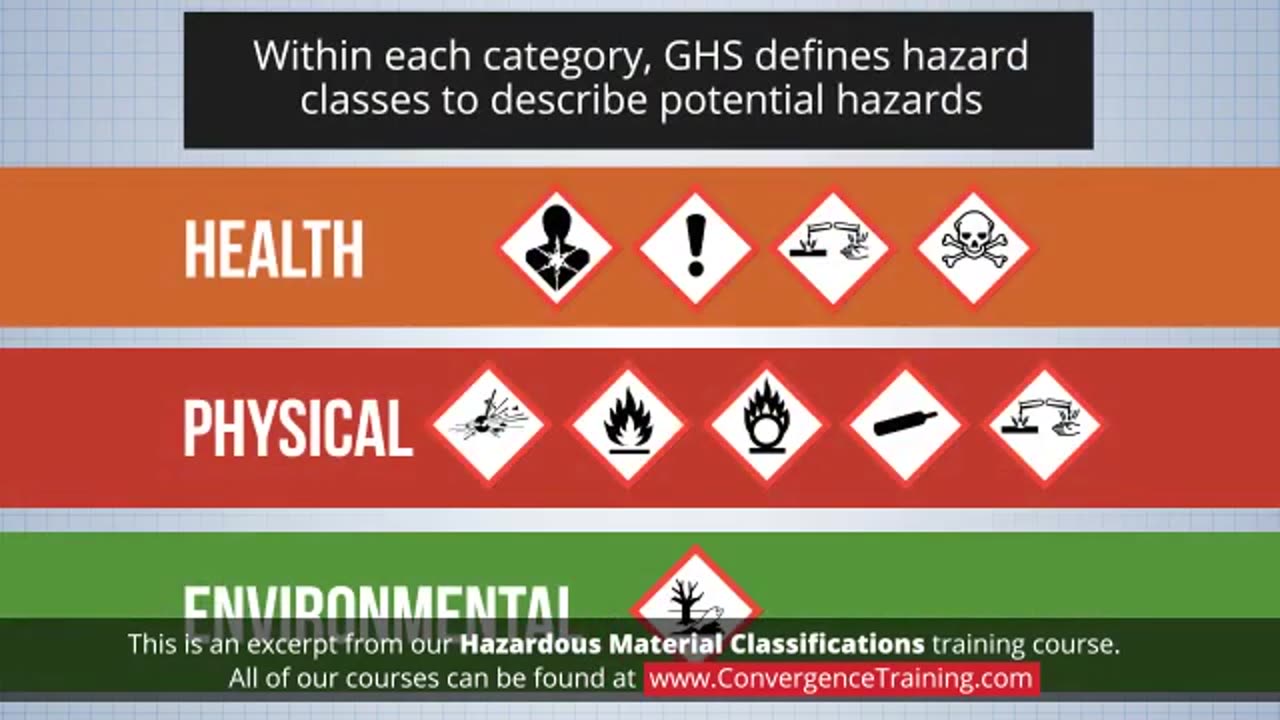Premium Only Content

Hazardous Material Classifications
**Hazardous Material Classifications** categorize materials based on their chemical, physical, and health hazards. These classifications are used for safe handling, storage, and disposal of hazardous materials and are governed by several regulatory frameworks such as OSHA (Occupational Safety and Health Administration), the Globally Harmonized System (GHS), and NFPA (National Fire Protection Association). Below are common hazardous material classifications:
### 1. **OSHA Hazard Communication Standard (HCS) Classifications**:
OSHA's Hazard Communication Standard (29 CFR 1910.1200) aligns with the Globally Harmonized System (GHS) to classify chemicals based on their physical and health hazards. The classification includes:
- **Physical Hazards**:
- **Flammable**: Materials that catch fire easily (e.g., gasoline, alcohol).
- **Explosives**: Materials that can cause explosions (e.g., TNT, fireworks).
- **Corrosive to Metals**: Chemicals that can cause damage to metal surfaces (e.g., acids like hydrochloric acid).
- **Compressed Gases**: Gases stored under high pressure (e.g., oxygen, propane).
- **Self-Reactives**: Chemicals that can undergo self-heating or decomposition (e.g., hydrogen peroxide).
- **Health Hazards**:
- **Acute Toxicity**: Materials that can cause severe injury or death after a single exposure (e.g., cyanide).
- **Carcinogenicity**: Chemicals that may cause cancer (e.g., asbestos, benzene).
- **Reproductive Toxicity**: Substances that may harm fertility or cause birth defects (e.g., lead, mercury).
- **Skin Corrosion/Irritation**: Chemicals that can cause damage to skin or result in irritation (e.g., sulfuric acid).
- **Respiratory Sensitizers**: Chemicals that may cause asthma-like symptoms (e.g., isocyanates).
### 2. **Globally Harmonized System (GHS) Classifications**:
The GHS system, adopted by OSHA, includes similar classifications but with a more detailed system of hazard symbols, signal words, and hazard statements. GHS hazard classes include:
- **Physical Hazards**: Such as flammability, reactivity, and pressure hazards.
- **Health Hazards**: Including toxicity, carcinogenicity, and reproductive hazards.
- **Environmental Hazards**: Covering substances that are harmful to aquatic life or the environment.
The GHS uses **pictograms** (e.g., a flame for flammable substances, a skull for toxicity) and **signal words** ("danger" or "warning") to further communicate risks.
### 3. **NFPA (National Fire Protection Association) Classification**:
The **NFPA label** uses a color-coded diamond with numbers from 0 (least hazardous) to 4 (most hazardous) in three categories:
- **Health (Blue)**: Indicates the level of health risk (e.g., 0 = no hazard, 4 = deadly).
- **Flammability (Red)**: Indicates the material's flammability (e.g., 0 = will not burn, 4 = extremely flammable).
- **Reactivity (Yellow)**: Indicates the material's potential to react or explode (e.g., 0 = stable, 4 = may detonate).
This system is widely used in industrial settings to provide quick visual cues about chemical hazards.
### 4. **EPA (Environmental Protection Agency) Classifications**:
The EPA regulates hazardous waste under the Resource Conservation and Recovery Act (RCRA). Wastes are classified as:
- **Listed Waste**: Specifically named by the EPA, such as certain solvents or pesticides.
- **Characteristic Waste**: Materials that exhibit one of four characteristics: ignitability, corrosivity, reactivity, or toxicity.
### 5. **Additional Hazardous Material Classifications**:
- **Toxicity**: Substances that can cause harm to human health or the environment, categorized by the degree of toxicity (e.g., extremely toxic, moderately toxic).
- **Corrosive Materials**: Substances that cause irreversible damage to living tissues or materials upon contact (e.g., acids, bases).
- **Environmental Hazards**: Materials that can cause harm to ecosystems, particularly aquatic environments (e.g., oil spills).
### Importance of Hazard Classification:
- **Safety**: Proper classification helps in assessing risks and implementing appropriate controls, reducing accidents and injuries.
- **Compliance**: Ensures adherence to regulatory requirements such as OSHA standards, the EPA, and GHS.
- **Emergency Response**: Facilitates quicker and more effective emergency responses by providing clear hazard information.
By correctly classifying hazardous materials, organizations can ensure that workers, emergency responders, and regulatory bodies are aware of potential risks and take appropriate precautions.
### Sources:
- OSHA Hazard Communication Standard (29 CFR 1910.1200)
- Globally Harmonized System (GHS) of Classification and Labeling of Chemicals
- National Fire Protection Association (NFPA) standards.
-
 3:14:33
3:14:33
Joe Donuts Gaming
4 hours ago🟢 Live : Christmas is Here!! | Fortnite, Caroling, Light Tours and Donos !!
17K6 -
 LIVE
LIVE
CLUJ
3 hours agoCHRISTMAS EVENING HYPE!! LETS HAVE FUN GAMING!!
698 watching -
![I AM FINALLY BACK :: PUBG: BATTLEGROUNDS :: RUMBLE NOW HAS GIFTED SUBS!!! [Merry Christmas] {18+}](https://1a-1791.com/video/fwe1/22/s8/1/e/f/C/6/efC6v.0kob-small-I-AM-FINALLY-BACK-PUBG-BATT.jpg) LIVE
LIVE
a12cat34dog
5 hours agoI AM FINALLY BACK :: PUBG: BATTLEGROUNDS :: RUMBLE NOW HAS GIFTED SUBS!!! [Merry Christmas] {18+}
146 watching -
 3:55:42
3:55:42
STARM1X16
5 hours agoMerry Christmas Fortnite
22.7K2 -
 2:45:33
2:45:33
Sgtfinesse
5 hours agoMerry Christmas Night
30.5K6 -
 LIVE
LIVE
tacetmort3m
21 hours ago🔴 LIVE - (MERRY CHRISTMAS) TIME TO SPREAD DEMOCRACY - HELLDIVERS 2 OMENS OF TYRANNY
59 watching -
 12:42
12:42
Cooking with Gruel
19 hours agoBrown Butter Trifle with Salted Caramel and Cinnamon Apple
10.1K3 -
 2:46
2:46
BIG NEM
8 hours agoDiscovering RAKIJA: The Holy Liquer of the Balkans
8.05K2 -
 1:11:38
1:11:38
Film Threat
13 hours agoCHRISTMAS DAY CHILL STREAM WITH CHRIS GORE | Hollywood on the Rocks
131K24 -
 14:22:40
14:22:40
The Quartering
1 day agoYule Log Christmas MAGA Edition With Memes! Come Hang Out!
221K29